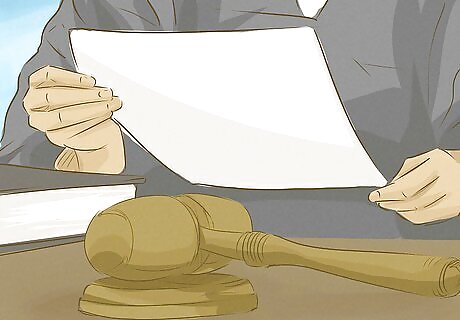
views
X
Research source
Handling Summary Probate

File the will with the probate court. To initiate proceedings, you must file the pour-over will, typically along with any other estate planning documents, with the clerk of the probate court in the county where the deceased person was a resident. The clerk will have forms you must fill out to formally file the will and petition the court to enter it into probate. You typically must pay a filing fee to file the will and any supporting documents, as well as have the probate petition served on major beneficiaries. In the case of a pour-over will, this typically would mean you must have the probate petition served on the successor trustee.

Have an executor appointed. Even if the pour-over will names an executor, that person must be officially appointed by a probate judge and given certificates that establish that person's authority to act on behalf of the estate. In some situations, particularly if the pour-over will itself and the other documents you've filed are simple and straightforward, the probate judge may not even order a hearing. However, if you are appointed executor you still typically must make another trip to the courthouse to be sworn in as a fiduciary and pick up your certificates.

Complete an inventory of the probate estate. The appointed executor or personal representative must make an inventory of the deceased person's assets not already transferred to their living trust. The probate court has a form you can use to inventory the property in the estate. You may want to make additional copies of this form so you can file a clean copy with the court that you've typed or completed in ink. Typically there will be very little property involved, mostly small items of personal property. In most cases you can just provide a ballpark estimate of the value of these items – you aren't expected to get an appraisal of usual personal items like household furniture or clothing. If the deceased person owned personal property of significant value that wasn't transferred to the trust prior to death, such as jewelry or artwork, these items may need to be appraised by a licensed professional appraiser. When you've filed out the inventory form, take the original along with at least two copies to the probate clerk's office. The original will be filed; the copies are for the estate's records and the successor trustee.

File a motion for summary administration. Given that most of the deceased person's assets likely were already held by the estate prior to their death, the pour-over will typically qualifies for a quicker and more simplified probate process. The probate court should have a form that you can fill out to request summary administration. Ask the probate clerk or check the probate court's website. Keep in mind you typically will have to pay a filing fee to file this motion, and you may have to have it served on major beneficiaries – for a pour-over will, this would typically be the successor trustee. Any filing fees or other court costs should be paid out of the estate, not out of your own pocket. Virginia and Delaware don't have summary administration proceedings, but all other states do. Each state has its own eligibility requirements for summary administration, so check those before you file your motion and make sure the estate qualifies. The major eligibility requirement concerns the value of the property in the estate. Estates worth more than a certain amount are not eligible for summary administration, although this value varies significantly among states. For example, an estate must be worth less than $30,000 to qualify for summary administration in New York. However, Nevada sets that ceiling at $200,000.
Transferring Assets

Meet with the successor trustee. If you are the executor or personal representative of the estate, you'll need to get together with the successor trustee and review the trust instrument to determine how to transfer any property covered by the pour-over will. During the first few months after the person's death, the successor trustee and the executor – assuming they aren't the same person – must keep in close contact with each other and report regularly on actions made on behalf of the estate. If there are several significant pieces of personal property or real estate that need to be transferred to the trust, it can be helpful to make a list or spreadsheet so you can note the requirements for transfer of ownership. If you are serving as executor, offer to assist the successor trustee in notifying the beneficiaries or gathering property to transfer into the trust.

Identify assets not included in the trust. Using the inventory filed with the court, find the assets and the ownership documents that will need to be amended to transfer ownership of those assets to the trust. For items of significant value that don't have a title or other legally recognized ownership document, the executor may need to prepare a basic assignment or bill of sale document that transfers all rights in that property to the trust. If you need to transfer real property deeds, go to the county clerk or recorder in the county where the property is located. The deed will be recorded there.

Transfer deeds or titles to the trust. Deeds for real property and titles for certain personal property such as cars or boats must be transferred to the trust using whatever transfer requirements and formalities are established by state and local law. The law that applies typically is the law of the state or county where the property is located, if in a different state or county than the deceased person's primary residence. Depending on the type of asset, you may not be able to transfer title to the trust's name without some difficulty. For example, if your state requires all cars to have auto insurance, you may have a hard time finding an insurer who will write a policy for a car owned by a trust rather than an individual person, because there's no way to check a driving record. In those situations, the successor trustee and the executor should get together with an experienced probate attorney and discuss their options. It may be possible to simply transfer ownership of the car directly to the beneficiary. To transfer ownership of real property, the executor typically must create a new quitclaim deed, sign it under the witness and notary formalities required by the state where the property is located, and record it with the county clerk.
Closing the Estate

Notify the deceased person's creditors. After all property has been transferred to the trust, the successor trustee is responsible for gathering the financial records of the deceased person and notifying their creditors of the death. In addition to creditors, the successor trustee also will be responsible for notifying Social Security and the state Department of Health of the death. Even though you're not using probate court, the court may have a notice form that you can use as a guide to draft your own. Make sure you don't use the probate court's form itself, as it will direct creditors to file their claims with the court. You also may be able to find creditor notice forms through various legal forms providers online. Make sure the form you use meets your state's legal requirements. Include a firm deadline on your notice – you might want to check the probate court's rules regarding how long a creditor has to file a claim and use that as a guide. Otherwise, creditors can file a claim against the trust whenever they want, and you'll have a hard time determining when assets can be distributed to the beneficiaries.

Review claims. In response to the notice, the deceased person's creditors will submit claims to the trustee that state the type of debt and the amount of money the deceased person owed them. These claims typically include some sort of proof of the validity of the debt. If no proof of the validity of the debt is included with the creditor's claim, you have the right as the successor trustee to demand it. If the validity isn't proven, you can legally dispute the validity of the debt and refuse to pay it. Keep in mind that unlike probate proceedings, if you are closing an estate through a living trust you don't have the benefit of a statute of limitations on claims. This often can make it more difficult to wind up an estate unless you have a firm grasp on the deceased person's debts and can easily get in contact with their creditors.

Pay debts and taxes. The successor trustee is responsible for paying off all of the deceased person's debts and filing that person's final income tax returns as well as any estate taxes that may be owed. If it hasn't already been done, the successor trustee must get an employer identification number (EIN) for the trust and set up a trust bank account to handle payments as well as monetary distributions to beneficiaries. You can get an EIN using the electronic application system on the IRS's website. It's free and you'll receive the trust's EIN immediately. The trust's EIN should be used to open a bank account for the trust and to file trust taxes. When you file the deceased person's final income tax return, however, you should use their Social Security number – not the trust's EIN. If assets in the trust generate $600 or more in income, you must file an income tax return for the estate as well. If there are not enough monetary assets in the trust to cover the deceased person's debts, as successor trustee you'll have to arrange an estate sale to sell estate assets to cover those debts. Unlike wills filed in probate, you don't need any court approval to sell any estate assets including real property.

Distribute the remaining trust property. Once the successor trustee is satisfied that all debts and taxes have been paid and there are no outstanding claims, they will distribute the property still held in the trust to the trust beneficiaries according to the terms of the trust instrument. If any of the trust's beneficiaries are children under the age of 18, the trust instrument typically will state how those assets are to be handled. In most cases, they are held in trust until the child reaches a certain age – usually 18 or 21. For titled personal property or deeded real property, the ownership documents must be transferred using the transfer of ownership rules and requirements of the state and county in which the property is located.




















Comments
0 comment